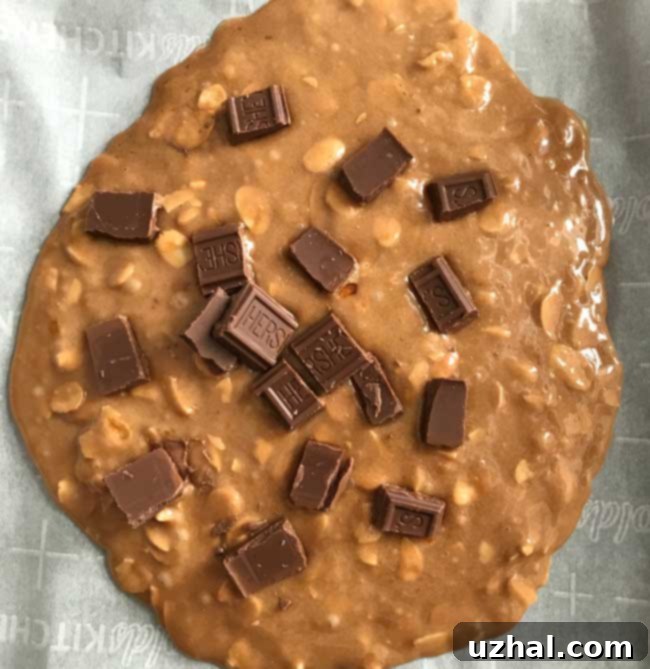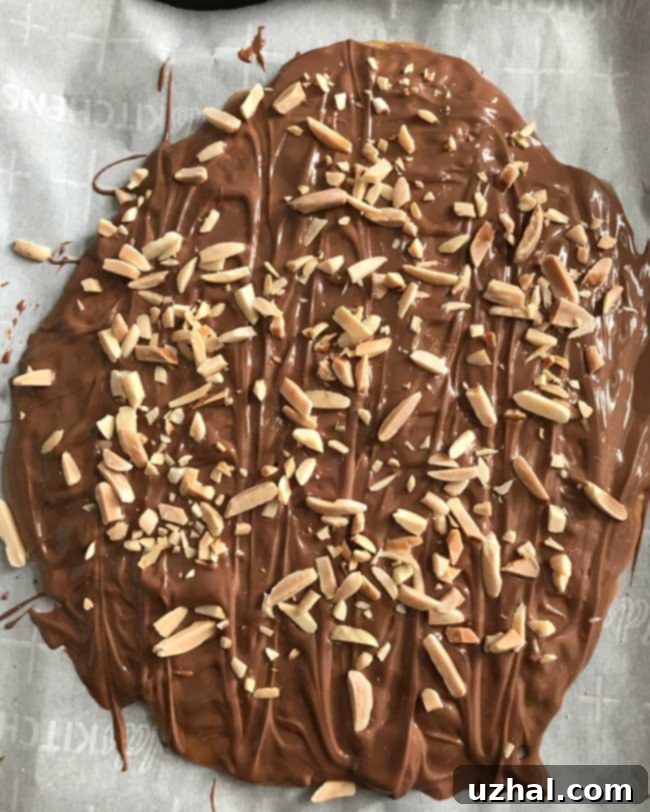Best-Ever Small Batch Almond Toffee Recipe: Your Guide to Irresistible Homemade Candy
Welcome to the ultimate guide for making the Best-Ever Almond Toffee, a confection so delightful it’s often referred to as Almond Crunch or a homemade version of the famous Almond Roca. This recipe isn’t just a dessert; it’s a tradition, a cherished favorite that has brought joy to countless kitchens for decades. I’ve personally shared this exact formula for years, and nothing makes me happier than receiving emails from enthusiastic bakers who tell me it won a contest or that they’ve mastered it, making it *their* signature recipe. If you’ve ever dreamt of creating exquisite, buttery, and crunchy almond toffee at home but felt intimidated, this easy small-batch version is the perfect starting point. It simplifies the process without compromising on the spectacular flavor and texture that makes this candy truly legendary.
Jump to Recipe

Essential Equipment for Perfect Homemade Almond Toffee
While making candy might sound complex, the right tools make all the difference. For this delicious small batch almond toffee, you won’t need an arsenal of specialty items, but a few key pieces of equipment are non-negotiable for achieving that perfect, consistent result. Naturally, a reliable stove is central to the process. Beyond that, here’s a breakdown of what you’ll need and why each item is crucial:
- Stove: Any standard stovetop will work, but consistent heat control is vital.
- 2 to 2 ½ Quart Nonstick Saucepan: This specific size is perfect for a small batch, preventing overflow and ensuring the candy cooks evenly. The nonstick surface makes for easier stirring and cleanup.
- High-Quality Candy/Deep Fry Thermometer: Absolutely essential for accurate temperature readings. Precision is key when making toffee.
- Wooden Spoon: Ideal for stirring as it doesn’t conduct heat as quickly as metal and won’t scratch your nonstick pan.
- Rimmed Pan Lined with Parchment Paper: A standard baking sheet (jelly roll pan) with a rim is needed to contain the hot toffee. Parchment paper is vital for easy removal once cooled.
- Heat-Safe Plate or Tray: For safely resting your hot candy thermometer after use.
- Spatula or Off-Set Spreader: Useful for spreading melted chocolate evenly.
- Airtight Container: For proper storage of your finished toffee.
Choosing the Right Saucepan: Size and Material Matter
The saucepan you use is more critical than you might think when it comes to candy making. This small batch almond toffee recipe is roughly half the size of my original Best Ever Almond Toffee, which calls for a 3 ½ quart pan. For this scaled-down version, a 2 to 2 ½ quart pan is ideal. The most important characteristic of your chosen pan is that it should be thick and heavy-bottomed. This design ensures superior heat distribution, preventing hot spots that can scorch your sugar and ruin the delicate balance of the toffee. Insulated anodized aluminum nonstick pans are particularly effective because they maintain a more consistent temperature throughout the cooking process, leading to a perfectly even cook. I’ve had great success lately with a 2 ½ quart All-Clad Anodized pan, but a good quality 2-quart pan or even one slightly larger will also perform admirably. Avoid thin, lightweight pans, as they are prone to uneven heating and burning the sugar.
The Importance of a Reliable Deep Fry Candy Thermometer
When making candy, especially toffee, precision is paramount, and a good quality candy thermometer is your best friend. It’s not just a recommendation; it’s an absolute necessity to ensure your almond toffee reaches the perfect “hard crack” stage (290-300°F). My personal favorite is a deep fry candy thermometer by Taylor. What sets it apart is its slightly elevated bulb, which allows you to position it perfectly in the center of the pan without it touching the bottom. This prevents inaccurate readings caused by direct contact with the hot metal of the pan. These types of thermometers are generally much more durable and accurate than the smaller, more fragile glass ones often found in grocery stores, which tend to break easily. Before you start, always double-check that your thermometer is properly calibrated. You can do this by placing it in boiling water; it should read 212°F (100°C) at sea level. If it’s off, note the difference and adjust your target temperatures accordingly. A reliable thermometer eliminates guesswork, ensuring your toffee comes out perfectly crunchy every time.

Step-by-Step Guide to Making Small Batch Almond Toffee
Making homemade almond toffee is a rewarding process that requires a little preparation and attention to detail. The key to success lies in having all your ingredients and equipment ready before you even turn on the stove. This ensures a smooth, stress-free experience, especially since you’ll need to act quickly at critical temperature points. Here’s a detailed breakdown of each step, designed to guide you to toffee perfection:
- Step One: Prepare the Toasted Almonds (¼ cup). Begin by toasting about ¼ cup of your sliced almonds. You can do this in a dry skillet over medium heat for a few minutes, stirring frequently until fragrant and lightly golden. Alternatively, use a toaster oven or a regular oven at 350°F (175°C) for about 5-7 minutes. Once toasted, set these aside on a separate plate; they will be sprinkled on top of the finished toffee.
- Step Two: Organize Your Mise en Place. “Mise en place” means “everything in its place,” and it’s vital for candy making. Measure out the remaining ½ cup of untoasted sliced almonds, ¼ teaspoon of baking soda, and ensure your rimmed pan lined with parchment paper is sitting right next to your stove. Have an empty plate or small pan nearby to quickly place your hot candy thermometer on when it’s removed from the candy.
- Step Three: Gentle Melting and Blending. In your heavy-bottomed 2 to 2 ½ quart nonstick saucepan, gently melt the unsalted butter over low heat. Once melted, add the warm water and salt. Stir gently to combine. Remove the pan from the heat and add the granulated sugar. Continue to stir until all the ingredients are evenly blended and the sugar is dissolved. This pre-blending is crucial for preventing separation and ensuring a smooth, uniform candy base. Insert your deep-fry thermometer, making sure the bulb is suspended in the mixture and not touching the bottom of the pan.
- Step Four: The First Boil – Reaching 240°F (Soft Ball Stage). Place the saucepan back on the stove over medium-low to medium heat. Bring the mixture to a controlled, steady boil. At this stage, you don’t need to stir constantly; an occasional stir to prevent sticking is fine. Watch your thermometer carefully. The goal is to slowly and steadily bring the mixture to 240°F (115°C). This typically takes about 10 minutes. Resist the urge to rush this process by cranking up the heat, as this can lead to uneven cooking or burning. The mixture will be a light, pale caramel color.
- Step Five: Incorporate Almonds and Reach 290°F (Hard Crack Stage). Once the candy mixture hits 240°F, immediately add the remaining ½ cup of untoasted sliced almonds. The addition of the cooler almonds will cause the temperature to drop. Now, it’s time for constant attention! Stir the mixture continuously with your wooden spoon, keeping the heat steady. The temperature will begin to rise again, slowly at first, then more rapidly. You’ll notice the candy transform from a pale white to a beautiful light brown caramel color. Continue stirring until the mixture reaches precisely 290°F (143°C). This stage, from 240°F to 290°F, should take approximately 10 to 13 minutes. Stir in a circular motion around the perimeter of the pan to ensure even cooking and prevent sticking.
- Step Six: Baking Soda and Pouring. As soon as the thermometer reads 290°F, swiftly remove the pan from the heat. Immediately stir in the ¼ teaspoon of baking soda. The baking soda will react with the hot sugar, causing the mixture to bubble up and lighten slightly in color and texture. This aeration is what gives toffee its characteristic crisp, brittle quality. Without delay, pour the bubbly, hot toffee onto your prepared parchment-lined pan. It should spread out relatively easily.
- Step Seven: Add Chocolate and Toasted Almonds. While the toffee is still very hot, scatter your chopped chocolate bits evenly over the surface. Allow the chocolate to sit for a few minutes, softening and melting from the residual heat of the toffee. Once it’s soft, use the back of a spoon or an offset spatula to gently spread the melted chocolate evenly across the toffee. Finally, sprinkle the reserved toasted almonds over the top of the melted chocolate.
- Step Eight: Cooling and Breaking. Allow the toffee to cool slightly at room temperature for about 15-30 minutes, just until it’s firm enough to handle without being too hot. Then, transfer the pan to the refrigerator or freezer to quick-set the chocolate and harden the toffee completely. This usually takes about 30-60 minutes in the refrigerator or 15-20 minutes in the freezer. Once fully set, carefully lift the parchment paper from the pan and break the almond toffee into irregular, delicious pieces. Enjoy your homemade masterpiece!
Expert Tips for Small Batch Almond Toffee Success
Even with a clear step-by-step guide, a few insider tips can elevate your almond toffee from good to truly phenomenal. These insights come from years of making this beloved candy and addressing common questions and challenges:
- Butter Quality Matters: Don’t skimp on butter! I highly recommend using a high-quality unsalted butter like Land O’Lakes or a similar premium brand. Better butter means better flavor and a smoother texture for your toffee. The fat content and purity directly impact the final taste.
- Almond Varieties: For the almonds mixed into the toffee, sliced almonds are excellent; they are thin and often come with bits of skin, which adds a rustic touch and flavor. While I typically use them, blanched (skinless) sliced almonds would also likely work well. The almonds that go on top, however, can be any type – chopped, slivered, or even whole – depending on your aesthetic preference.
- Toasting Only the Topping: Remember, only the almonds designated for the *topping* are toasted. The ½ cup of almonds that get stirred into the candy mixture remain untoasted. This creates a delightful contrast in texture and flavor between the tender almonds within the toffee and the crunchy, aromatic ones on top.
- Don’t Panic if It Doesn’t Set Immediately: This is a common concern for first-time candy makers. If you meticulously followed the instructions and cooked your toffee to precisely 290°F (the hard crack stage), it *will* set. Sometimes it just needs a bit more time to cool and firm up, especially if your kitchen is warm or humid. After adding the chocolate and placing it in the freezer or refrigerator, give it the recommended time. Most likely, it will firm up beautifully and be perfectly brittle.
- Experiment with Chocolate Toppings: This is where you can truly personalize your almond toffee! I adore using creamy milk chocolate from brands like Cadbury or Lindt, but dark chocolate offers a wonderful bittersweet contrast. White chocolate is another fantastic option for a different flavor profile. Feel free to use your favorite chocolate or a combination! You can also melt and drizzle multiple types for an artistic finish.
- Make Ahead and Freeze: Almond toffee is an ideal candy for preparing in advance. It freezes exceptionally well! Store cooled, broken pieces in an airtight container in the freezer for up to several months. This makes it perfect for holiday gifting or having on hand for unexpected guests.
- Get Creative with Decoration: For an extra special touch, explore chocolate transfer sheets available from craft stores or online retailers like Etsy. These sheets allow you to impress festive patterns onto the warm chocolate, creating professional-looking designs. Simply press a pattern onto the freshly spread chocolate, let it set, and then peel off the sheet to reveal a beautiful design. It’s a fun and impressive technique!
- Humidity is the Enemy: Candy making on a humid day can be challenging. Excess moisture in the air can prevent your toffee from reaching the hard crack stage or cause it to become sticky after cooling. Try to make toffee on a dry day if possible.
- Clean Your Pan Edges: As the candy boils, sugar crystals can form on the sides of the pan. These can fall back into the mixture and cause your toffee to crystallize or become grainy. Use a pastry brush dipped in warm water to gently wash down the sides of the pan during the initial boiling stage (before adding almonds).
- Safety First: Remember that hot sugar is extremely hot and can cause severe burns. Always exercise caution and never touch the molten candy. Have a bowl of ice water nearby in case of accidental splashes, but prioritize preventing them.

Good luck with this small batch almond toffee recipe! I am confident that with these detailed instructions and helpful tips, you’ll create a batch of candy that’s crunchy, buttery, and utterly irresistible. And who knows, this easy small-batch success might just inspire you to tackle a larger batch next time, sharing even more of this incredible homemade delight with friends and family. Happy candy making!
More Delicious Sweets to Explore
- Mary K.’s Never Ending Chocolate Cake
- Chocolate and Peanut Butter Crescents
- Toffee Chunk Oat Cookies
- Mini Peanut Butter Chocolate Chip Toffee Cookies
- Mini Peanut Butter Cups Toffee Chunk Cookies
Recipe

Best-Ever Almond Toffee (Small Batch)
Anna
Pin Recipe
Ingredients
- ¾ cup sliced almonds divided use
- 1 stick unsalted butter, cut into 1-inch chunks (114 grams)
- ¼ cup warm water
- ¼ teaspoon salt
- ½ cup granulated sugar
- ¼ teaspoon baking soda
- 4-6 ounces good quality dark or milk chocolate chopped
Instructions
-
Toast ¼ cup of the sliced almonds and set aside. You can toast in a toaster oven, a regular oven at 350°F (175°C) for about 6 minutes, or briefly in a dry skillet over medium heat, stirring often. Set aside for topping.
-
Arrange all your remaining ingredients and equipment next to the stove: the remaining ½ cup of untoasted sliced almonds, ¼ teaspoon of baking soda, and the parchment-lined rimmed sheet pan. Have an empty plate ready for the hot thermometer.
-
Place butter, warm water, and salt in a heavy-bottomed 2 to 2 ½ quart saucepan. Melt gently over low heat, stirring occasionally, until the butter is completely liquid and combined. Remove from heat and stir in the granulated sugar until thoroughly blended and uniform. This step helps prevent separation later.
-
Carefully clip your deep-fry thermometer to the side of the pan, ensuring the bulb is immersed in the mixture but does not touch the bottom of the pan.
-
Return the pan to medium-low heat. Bring the mixture to a slow, controlled boil. Stir once or twice during this phase to ensure even heating, but constant stirring is not necessary. Cook until the thermometer registers 240°F (115°C), which should take at least 10 minutes. Maintain a gentle boil; do not rush the temperature rise.
-
Once the mixture reaches 240°F, immediately add the remaining ½ cup of untoasted sliced almonds. Stir constantly with a wooden spoon as the temperature will drop. Continue stirring over steady heat until the mixture reaches 290°F (143°C). The candy will change from a pale color to a rich, light golden brown. This stage should take no longer than 13 minutes.
-
As soon as the mixture hits 290°F (it’s better to be slightly over than under), remove the pan from the heat immediately. Quickly stir in the ¼ teaspoon of baking soda. The candy will bubble up and lighten slightly as air is incorporated. This creates its signature crisp texture.
-
Pour the hot, bubbly toffee mixture quickly and evenly onto the prepared parchment-lined pan. The mixture should spread out somewhat. Don’t worry if a little butter separates or pools; it will reincorporate as it cools. If the toffee doesn’t immediately firm up, don’t panic. As long as it reached 290°F, it will set. Sometimes it just takes a bit longer.
-
Scatter the chopped chocolate generously across the top of the hot almond toffee. Let it sit for a few minutes to melt from the residual heat. Once softened, use the back of a spoon or an offset spatula to gently spread the melted chocolate evenly over the candy surface.
-
Sprinkle your crushed toasted almonds over the melted chocolate. Allow the candy to cool at room temperature for about ½ hour to firm up slightly. Then, transfer the pan to the refrigerator or freezer and chill for approximately 1 hour (or until firm) to fully set the chocolate and harden the toffee.
-
Once the chocolate is completely set and the toffee is hard, lift the candy from the pan by grasping the parchment paper. Break the candy into desired large or small chunks.
-
This recipe makes approximately 10 ounces of delicious almond toffee. Store in an airtight container at room temperature for up to 2 weeks, or freeze for longer storage.
- Mary K.’s Never Ending Chocolate Cake
- The End – Coconut Oil Gingersnaps
- Toffee Chunk Oat Cookies
- Mini Peanut Butter Chocolate Chip Toffee Cookies
- Mini Peanut Butter Cups Toffee Chunk Cookies